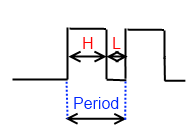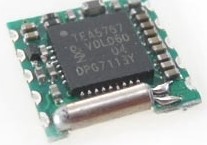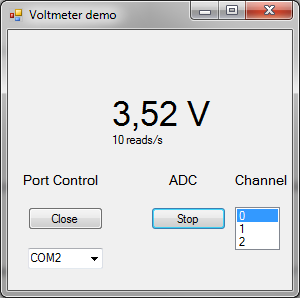This meter gives the best results at 0 – 1000 Hz range. It works by measuring square wave total and high period duration using 16 bit hardware counter.

As you may know frequency = 1/Period and Duty Cycle = High period duration/total period duration.
This meter gives the best results at 0 – 1000 Hz range. It works by measuring square wave total and high period duration using 16 bit hardware counter.

As you may know frequency = 1/Period and Duty Cycle = High period duration/total period duration.
LCD in this picture has 2×16 characters, so in quick way horizontal bar could have 16 steps resolution, but it’s not enough. Each character is formed from 5×8 pixels. Every character can be sliced in to 5 pieces. After that we can have 5*16 = 80 steps.
First step is to create 5 custom characters. More about createChar() please read at arduino.cc.
Each custom character is specified by an array of eight bytes. Byte represents character’s row.
![fm.mp4_snapshot_00.42_[2011.02.08_14.45.25]](https://www.electronicsblog.net//wp-content/uploads/fm.mp4_snapshot_00.42_2011.02.08_14.45.25-300x168.jpg)
Old wish to make digitally controlled FM tuner come true when I found on Ebay cheap module with TEA5767 (Low-power FM stereo radio for handheld applications).

This module size is only 11.2mm x 11mm. TEA 5767 supports I2C. Pinout and wiring:
For antenna i have used just 75 cm long wire, because that is 1/4 of wavelength at 100 MHz. TEA5767 doesn’t have audio amplifier, sound output level is very low, headphone can not be connected directly. During testing i had connected audio output to PC audio system.
GPS for accurate synchronization and position measurement must use precise clock, so GPS satellites are equipped with atomic clocks. Clock accuracy is amazing ± 1 second in 1 million years. Using GPS module is available not only acquire position, speed, bet also time and date, so in this post I’ll explain how to do it.
GPS clock consist of old Sirf II GPS module, MAX 232, Arduino Mega and LCD display (Hitachi HD44780).
Sirf II module has RS-232 interface for communication and it can be connected to PC Com port. Atmega in Arduino board has UART interface. RS-232 basically is the same UART, only zeros and ones voltage levels are different. To match levels MAX232 driver is used. Today’s GPS modules have UART port, so there isn’t any need for MAX232.
Arduino in this project doesn’t have clock function it just pass time and date from GPS module to display. It works that way because GPS module has internal RTC(Real time clock) it’s not accurate, but it is synchronized to GPS system.
As you can see from video GPS module RTC is sychronised before GPS fix happens, but GPS fix is only one indicator that shows that clock is synchronised.
Continue reading

Today I will show how to make digital bridge between Arduino and PC: control analog – digital converter and send measured data to PC. Windows application will be created using Visual C++ 2008 Express.
Voltmeter demo software is very simple, and here is a lot room for improvement, but I just wanted to show basics how to control com port and execute data exchange between PC and Arduino.